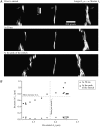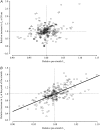Magnitude of sarcomere extension correlates with initial sarcomere length during lengthening of activated single fibers from soleus muscle of rats
- PMID: 18469072
- PMCID: PMC2483783
- DOI: 10.1529/biophysj.107.118109
Magnitude of sarcomere extension correlates with initial sarcomere length during lengthening of activated single fibers from soleus muscle of rats
Abstract
A laser-diffraction technique was developed that rapidly reports the lengths of sarcomeres (L(s)) in serially connected sectors of permeabilized single fibers. The apparatus translates a laser beam along the entire length of a fiber segment within 2 ms, with brief stops at each of 20 contiguous sectors. We tested the hypothesis that during lengthening contractions, when maximally activated fibers are stretched, sectors that contain the longer sarcomeres undergo greater increases in L(s) than those containing shorter sarcomeres. Fibers (n = 16) were obtained from the soleus muscles of adult male rats and the middle portions (length = 1.05 +/- 0.11 mm; mean +/- SD) were investigated. Single stretches of strain 27% and a strain rate of 54% s(-1) were initiated at maximum isometric stress and resulted in a 19 +/- 9% loss in isometric stress. The data on L(s) revealed that 1), the stretch was not distributed uniformly among the sectors, and 2), during the stretch, sectors at long L(s) before the stretch elongated more than those at short lengths. The findings support the hypothesis that during stretches of maximally activated skeletal muscles, sarcomeres at longer lengths are more susceptible to damage by excessive strain.
Figures








Similar articles
-
Non-uniform distribution of strain during stretch of relaxed skeletal muscle fibers from rat soleus muscle.J Muscle Res Cell Motil. 2011 Aug;32(1):39-48. doi: 10.1007/s10974-011-9250-0. Epub 2011 Jun 28. J Muscle Res Cell Motil. 2011. PMID: 21710358 Free PMC article.
-
Sarcomere dynamics and contraction-induced injury to maximally activated single muscle fibres from soleus muscles of rats.J Physiol. 1997 Apr 15;500 ( Pt 2)(Pt 2):523-33. doi: 10.1113/jphysiol.1997.sp022038. J Physiol. 1997. PMID: 9147335 Free PMC article.
-
The magnitude of the initial injury induced by stretches of maximally activated muscle fibres of mice and rats increases in old age.J Physiol. 1996 Dec 1;497 ( Pt 2)(Pt 2):573-80. doi: 10.1113/jphysiol.1996.sp021790. J Physiol. 1996. PMID: 8961197 Free PMC article.
-
Sarcomere mechanics in striated muscles: from molecules to sarcomeres to cells.Am J Physiol Cell Physiol. 2017 Aug 1;313(2):C134-C145. doi: 10.1152/ajpcell.00050.2017. Epub 2017 May 24. Am J Physiol Cell Physiol. 2017. PMID: 28539306 Review.
-
The vertebrate muscle Z-disc: sarcomere anchor for structure and signalling.J Muscle Res Cell Motil. 2009;30(5-6):171-85. doi: 10.1007/s10974-009-9189-6. Epub 2009 Oct 15. J Muscle Res Cell Motil. 2009. PMID: 19830582 Free PMC article. Review.
Cited by
-
Decreased specific force and power production of muscle fibers from myostatin-deficient mice are associated with a suppression of protein degradation.J Appl Physiol (1985). 2011 Jul;111(1):185-91. doi: 10.1152/japplphysiol.00126.2011. Epub 2011 May 12. J Appl Physiol (1985). 2011. PMID: 21565991 Free PMC article.
-
The role of transmembrane proteins on force transmission in skeletal muscle.J Biomech. 2014 Sep 22;47(12):3232-6. doi: 10.1016/j.jbiomech.2014.07.014. Epub 2014 Jul 30. J Biomech. 2014. PMID: 25113807 Free PMC article.
-
Non-uniform distribution of strain during stretch of relaxed skeletal muscle fibers from rat soleus muscle.J Muscle Res Cell Motil. 2011 Aug;32(1):39-48. doi: 10.1007/s10974-011-9250-0. Epub 2011 Jun 28. J Muscle Res Cell Motil. 2011. PMID: 21710358 Free PMC article.
-
Neuromechanical basis of region-specific differences and their implications for sport performance and injury prevention: a narrative review.Eur J Appl Physiol. 2025 Jul 25. doi: 10.1007/s00421-025-05889-w. Online ahead of print. Eur J Appl Physiol. 2025. PMID: 40711548 Review.
-
Lateral transmission of force is impaired in skeletal muscles of dystrophic mice and very old rats.J Physiol. 2011 Mar 1;589(Pt 5):1195-208. doi: 10.1113/jphysiol.2010.201921. Epub 2011 Jan 10. J Physiol. 2011. PMID: 21224224 Free PMC article.
References
-
- Faulkner, J. A. 2003. Terminology for contractions of muscles during shortening, while isometric, and during lengthening. J. Appl. Physiol. 95:455–459. - PubMed
-
- McCully, K. K., and J. A. Faulkner. 1985. Injury to skeletal muscle fibers of mice following lengthening contractions. J. Appl. Physiol. 59:119–126. - PubMed
-
- Friden, J., M. Sjostrom, and B. Ekblom. 1983. Myofibrillar damage following intense eccentric exercise in man. Int. J. Sports Med. 4:170–176. - PubMed
-
- Newham, D. J., G. McPhail, K. R. Mills, and R. H. Edwards. 1983. Ultrastructural changes after concentric and eccentric contractions of human muscle. J. Neurol. Sci. 61:109–122. - PubMed
-
- Ogilvie, R. W., R. B. Armstrong, K. E. Baird, and C. L. Bottoms. 1988. Lesions in the rat soleus muscle following eccentrically biased exercise. Am. J. Anat. 182:335–346. - PubMed
MeSH terms
LinkOut - more resources
Full Text Sources

